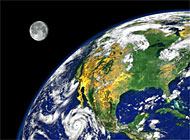Apollo samples reveal moon’s secrets

Lunar samples brought back by the Apollo astronauts are continuing to yield information about the origins of the moon.
A new study by the Federal Institute of Technology in Zurich has confirmed that the moon and the earth have the same concentrations of different types of oxygen. The finding is consistent with the giant impact theory of the moon’s formation.
“The object from which the moon came, which is thought to be a planet which collided with the earth, is basically made up of the same kind of material which formed the earth itself,” said Professor Alex Halliday of Zurich’s Institute for Isotope Geology and Mineral Resources.
The fact that the moon and the earth have exactly the same oxygen isotope composition has helped resolve a dilemma.
“The chemistry of the moon is quite different from the chemical composition of the earth,” said Halliday. “So it has not been clear whether the earth and moon came from different kinds of material in the solar nebula before the formation of the earth and moon or whether they actually were in some way genetically linked.”
Massive collision
The most widely accepted theory says the moon formed about four and a half billion years ago after a proto-planet, the size of Mars, crashed into an almost completely formed earth.
This massive collision – some 50 million years after the start of the solar system – would have blasted a jet of vaporised rock into space. A fraction of that debris went into orbit around the earth and aggregated into the moon.
The fact that lunar rocks show the same isotope composition as the earth whereas rocks from Mars and meteorites from other parts of the solar system have different oxygen isotope compositions has also puzzled scientists.
The best explanation, said Halliday, is that the impacting object was almost identical in composition to the proto-earth because it formed a similar distance from the sun as our own planet.
“As for the differences in chemistry between the earth and the moon – for example, the fact that there is no water on the moon and the differences in the amount of alkali elements like potassium and sodium – these things must have something to do with the way in which the moon formed or they happened to the earth after the moon formed and how that happened is not particularly clear.”
by Vincent Landon

In compliance with the JTI standards
More: SWI swissinfo.ch certified by the Journalism Trust Initiative








You can find an overview of ongoing debates with our journalists here . Please join us!
If you want to start a conversation about a topic raised in this article or want to report factual errors, email us at english@swissinfo.ch.